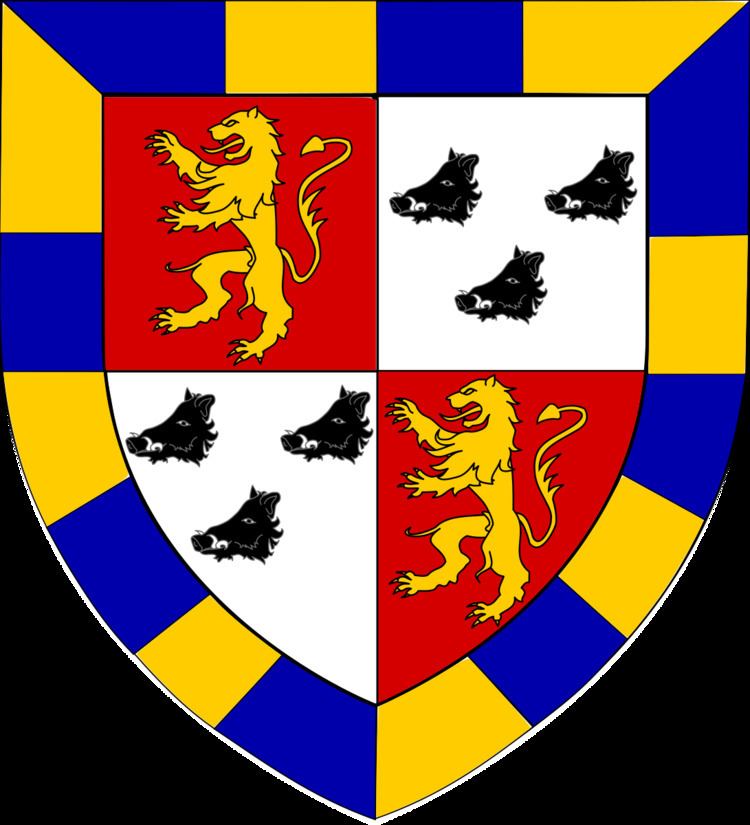 | ||
The Radnorshire Arms is a well-preserved Jacobean building in the Welsh border town of Presteigne, in Powys. In recent years, the Radnorshire Arms has been renovated and converted into an upmarket public house and hotel.
The building has been dated to 1616. Originally a private residence, it became an inn in 1792 and had several additions around 1875. The hotel is a Grade II* listed building.
The Radnorshire Arms has a rich and colorful history stretching back over four hundred years. Its paneled walls have seen murder, injustice and even a plot to bring down the English Monarchy The original building dates back to the mid-16th century, and was owned by one Sir Christopher Hatton, a lawyer and politician, Lord Chancellor of England and, according to popular rumour, lover of Queen Elizabeth I, who also owned neighboring property. Allegations of the affair were made public in 1584 by Mary, Queen of Scots, and in a strange twist of fate, Hatton was one of the commissioners who found her guilty of treason just three years later. He became Lord Chancellor that same year... That was not the end of the building's connection to the English throne however, for in 1616 (a date which still adorns the front porch of the building) it became home to a certain John Bradshaw. Bradshaw, who's family had lived in Presteigne since 1536, went on to become a prominent English judge, holding the post of President of the "Parliamentary Commission to try The King". He presided over the trial and subsequent death sentence of Charles I of England, and became known as "The Regicide". Bradshaw died in October 1659 and was buried in Westminster Abbey. When Charles II regained the throne in 1660, Bradshaw's body was exhumed and posthumously hanged and beheaded, along with the body of Oliver Cromwell. By the mid 1700s the building (known as Cross House at that time, due to the town cross standing almost opposite) came to be owned by Sir Henry Vaughan, a wealthy Radnorshire Land Owner. In March 1754, Vaughan was arrested for 'committing unnatural and repugnant acts', and the local community took the Law into their own hands. They pulled him from the building and bludgeoned him to death, dismembering his body and burying it under a cherry tree in the garden. Vaughan left behind a legacy of poetry and plays on the subject of Sadism, some of which is still on display at the local Museum, The Judge's Lodging. He is referred to by some as the British precursor to the far more widely known Marquis de Sade. The Radnorshire Arms sits atop an extensive network of tunnels and underground rooms, still accessible from the cellars today. These were reputedly used by William Vavasour, the Royalist Governor of Hereford, for the torture of Parliamentarian sympathizers’ during the English Civil War, but they are rumored to date back long before this. It is suggested that the original structure was built on the site of some outbuilding of Presteigne Castle (which was completely destroyed by Llwelyn The Great in 1261), perhaps a gatehouse, and made use of passages constructed many years before. Tunnels were said to have run to The Warden (the location of the old Castle, a few hundred yards away) and another under the River Lugg, frontier between England and Wales, and on to Stapleton Castle about a mile and a half away. There are also many anomalies inside the Hotel itself, caused by the large number of changes and additions to the original structure. This work continued through the 18th, 19th and 20th centuries, the three stores rear extension is Victorian, and the Garden Lodges weren't built until the 1970s. Such renovation work in 1875 revealed a secret chamber off of what is now the Resident's Lounge. This turned out to be a Priest Hole, and behind one of the panels was the diary of a Catholic Priest who had stayed hidden there for two years. The Priest Hole remains on show to this day, but the diary has long since gone. The Hotel's troubled history is not just a thing of distant memory. In 1927 a partial structural collapse caused the death of fourteen local people, and in 1932 a historic windmill which stood in the grounds was devastated by fire. A local farmhand, Bobby Millichamp, was tried and subsequently hung for causing the blaze. Further information came out after his death which proved his innocence, and his brother Arthur was tried and hung for the same offence in 1936. It is believed that the Radnorshire Arms first became an Inn in 1792. What is known for sure is that during the coaching era it was a major posting house on the London to Aberystwyth road, and had extensive stabling directly opposite. This popularity probably lead to the first major extension which was added around this time. Both this and the later Victorian extension retain the old style of black and white construction, and the building today presents a picturesque and charming, if somewhat jumbled, composite whole. The renovation work which is taking place at the moment also holds to the architectural traditions of this truly intriguing building.
